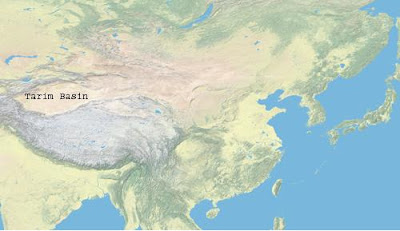Bronzes Don't Float!
On October 10, 2012, Professor Adam Smith gave a presentation on ancient Chinese bronze artifacts. Most Chinese are familiar in some
way with the story of the nine bronzes. Also known as the nine "ding" 九鼎 (jiu3ding4), or
bronze tripods that were originally cast by Yu the Great of the Xia Dynasty,
these bronzes were lost when they sank as they were being transported on the Si
River to the Qin capitol of Xianyang. While bronzes are usually a topic about
as dense as the material of which they are made up of, Professor Adam Smith
turned to a slightly lighter topic as he discussed "floating" bronzes
or, rather, the inscriptions on them for many of which the author, origins, and
other contextual information is unknown.
Bronzes were artifacts used in ancient times for rituals conducted by
the ruling elite. The peasantry provided the labor and craftsmen the skill -
the heads of the state in ancient China monopolized Bronze Age infrastructure,
technology, and products. Bronzes often have inscriptions detailing the endeavors
of its commissioner, i.e. a tale of one of the King's more successful ventures
that displays incredible virtue. Some do not have an inscription, but have
other mysterious stories behind them, like the one shown below. Known as the
Chen Zhang Fanghu (square vessel), it
originally belonged to the state of Yan, which was
crushed as the Qin Dynasty was born. Serving under general Zhong Hui (a playable
character in the popular Dynasty Warriors videogame), General Chen Zhang captured this fanghu and scratched some characters into it so
that all who later saw it would know he conquered Yan. The museum artifact page
can be viewed here.
Professor Smith discussed many particulars, but he focused primarily on
the inscriptions and how for many Bronzes with inscriptions or vanity
signatures, scholars really don't know who wrote them or why. In these
instances the text is "divorced" from the context of its production,
or "floating." The inscriptions purport to be a dialogue between
several learned/powerful individuals or an account of something that happened,
but at the end, give few or no evidence to where it came from.
Also, Professor Smith discussed the topic of literary texts on Bronzes.
What exactly is a literary text? In Chinese, an ancient literary text is
usually considered to be one of the profusely copied and transmitted classics
or other books that contain (usually Confucian) philosophical thought. He
argued that many of the inscriptions are neither literary texts nor refer to
literary texts - that is - that they are "free-floating," are not
replicated, do not have the universal appeal that other texts enjoy, and are
not often used as the basis for other texts.
Some inscriptions that Professor
Smith showed during his presentation included a couple lines from a bronze that
reflects ethical themes pervading the content of ancient Chinese bronzes. One
part of such an inscription reads:
When one's speech and etiquette are respectful, men of worth
will draw near;
When one's X and solicitude are deep, men of worth will
become one's intimates;
When agricultural labor and taxation are set just right, the
commoners will adhere.
Well, we might not know who wrote
these words or even whose words they are (although they may be attributed to
some head of an ancient Chinese State), standards for the ancient leaders were
pretty high. Perhaps our leaders could learn something from these early
inscribers of ancient Chinese artifacts.
The event was hosted by the Center for East Asian Studies in Steitler Hall B26.
The event was hosted by the Center for East Asian Studies in Steitler Hall B26.
F. Miller SAS '13


Comments
Post a Comment
We follow the House Rules as outlined by the BBC here.